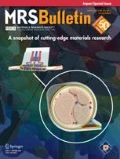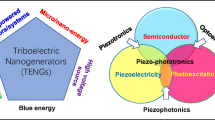Abstract
Developing wireless nanodevices and nanosystems is critical for sensing, medical science, environmental/infrastructure monitoring, defense technology, and even personal electronics. It is highly desirable for wireless devices to be self-powered without using a battery. We have developed piezoelectric nanogenerators that can serve as self-sufficient power sources for micro-/nanosystems. For wurtzite structures that have non-central symmetry, such as ZnO, GaN, and InN, a piezoelectric potential (piezopotential) is created by applying a strain. The nanogenerator uses the piezopotential as the driving force, responding to dynamic straining of piezoelectric nanowires. A gentle strain can produce an output voltage of up to 20–40 V from an integrated nanogenerator. Furthermore, piezopotential in the wurtzite structure can serve as a “gate” voltage that can effectively tune/control charge transport across an interface/junction; electronics based on such a mechanism are referred to as piezotronics, with applications such as electronic devices that are triggered or controlled by force or pressure, sensors, logic units, and memory. By using the piezotronic effect, we show that optoelectronic devices fabricated using wurtzite materials can provide superior performance for solar cells, photon detectors, and light-emitting diodes. Piezotronic devices are likely to serve as “mediators” for directly interfacing biomechanical action with silicon-based technology. This article reviews our study of ZnO nanostructures over the last 12 years, with a focus on nanogenerators and piezotronics.

















Similar content being viewed by others
References
Z.L. Wang, Mater. Sci. Eng. R 64, 33 (2009).
Z.L. Wang, J.H. Song, Science 312, 242 (2006).
Z.L. Wang, Adv. Funct. Mater. 18, 3553 (2008).
Z.L. Wang, R.S. Yang, J. Zhou, Y. Qin, C. Xu, Y.F. Hu, S. Xu, Mater. Sci. Eng. R 70, 320 (2010).
Z.L. Wang, Nanogenerators for Self-Powered Devices and Systems (Georgia Institute of Technology, SMARTech digital repository, 2011); http://hdl.handle.net/1853/39262.
Z.L. Wang, Nano Today 5, 540 (2010).
Z.L. Wang, Adv. Mater. (2012); doi:10.1002/adma.201104365.
Z.W. Pan, Z.R. Dai, Z.L. Wang, Science 291, 1947 (2001).
Z.L. Wang, Mater. Today 7, 26 (2004).
Z.L. Wang, X.Y. Kong, Y. Ding, P.X. Gao, W. Hughes, R.S. Yang, Y. Zhang, Adv. Funct. Mater. 14, 944 (2004).
X.Y. Kong, Z.L. Wang, Nano Lett. 3, 1625 (2003).
X.Y. Kong, Y. Ding, R.S. Yang, Z.L. Wang, Science 303, 1348 (2004).
W.L. Hughes, Z.L. Wang, J. Am. Chem. Soc. 126, 6703 (2004).
P.X. Gao, Y. Ding, W.J. Mai, W.L. Hughes, C.S. Lao, Z.L. Wang, Science 309, 1700 (2005).
M. Law, L.E. Greene, J.C. Johnson, R. Saykally, P.D. Yang, Nat. Mater. 4, 455 (2005).
X.D. Wang, J. Zhou, C.S. Lao, J.H. Song, N.S. Xu, Z.L. Wang, Adv. Mater. 19, 1627 (2007).
M.H. Huang, S. Mao, H. Feick, H.Q. Yan, Y.Y. Wu, H. Kind, E. Weber, R. Russo, P.D. Yang, Science 292, 1897 (2001).
J.H. Lim, C.K. Kang, K.K. Kim, I.K. Park, D.K. Hwang, S.J. Park, Adv. Mater. 18, 2720 (2006).
X.D. Wang, J.H. Song, J. Liu, Z.L. Wang, Science 316, 102 (2007).
Y. Qin, X.D. Wang, Z.L. Wang, Nature 451, 809 (2008).
Q.X. Zhao, M. Willander, R.R. Morjan, Q.H. Hu, E.E.B. Campbell, Appl. Phys. Lett. 83, 165 (2003).
X.D. Wang, C.J. Summers, Z.L. Wang, Nano Lett. 3, 423 (2004).
S. Xu, Z.L. Wang, Nano Res. 4, 1013 (2011).
Y.G. Wei, W.Z. Wu, R. Guo, D.J. Yuan, S. Das, Z.L. Wang, Nano Lett. 10, 3414 (2010).
S. Xu, C.S. Lao, B. Weintraub, Z.L. Wang, J. Mater. Res. 23, 2072 (2008).
Z.L. Wang, Sci. Am. 298, 82 (2008).
Y.F. Hu, L. Lin, Y. Zhang, Z.L. Wang, Adv. Mater. 24, 110 (2012).
R.S. Yang, Y. Qin, L.M. Dai, Z.L. Wang, Nat. Nanotechnol. 4, 34 (2009).
G. Zhu, R.S. Yang, S.H. Wang, Z.L. Wang, Nano Lett. 10, 3151 (2010).
Y.F. Hu, L. Lin, Y. Zhang, Z.L. Wang, Adv. Mater. 24, 110 (2012).
Y.F. Hu, Y. Zhang, C. Xu, G. Zhu, Z.L. Wang, Nano Lett. 10, 5025 (2010).
J.H. Jung, M.B. Lee, J.-I. Hong, Y. Ding, C.-Y. Chen, L.-J. Chou, Z.L. Wang, ACS Nano 5, 10041 (2011).
S. Xu, Y. Qin, C. Xu, Y.G. Wei, R.S. Yang, Z.L. Wang, Nat. Nanotechnol. 5, 366 (2010).
Y.F. Hu, Y. Zhang, C. Xu, L. Lin, R.L. Snyder, Z.L. Wang, Nano Lett. 11, 2572 (2011).
M.B. Lee, J.H. Bae, J.Y. Lee, C.S. Lee, S.H. Hong, Z.L. Wang, Energy Environ. Sci. 4, 3359 (2011).
C. Xu, X.D. Wang, Z.L. Wang, J. Am. Chem. Soc. 131, 5866 (2009).
C. Xu, Z.L. Wang, Adv. Mater. 23, 873 (2011).
B.J. Hansen, Y. Liu, R.S. Yang, Z.L. Wang, ACS Nano 4, 3647 (2010).
C.F. Pan, Z.T. Li, W.X. Guo, J. Zhu, Z.L. Wang, Angew. Chem. Int. Ed. 50, 11192 (2011).
A.F. Yu, P. Jiang, Z.L. Wang, Nano Energy (2012); doi:10.1016/j.nanoen.2011. 12.006.
Y. Zhang, Y. Liu, Z.L. Wang, Adv. Mater. 23, 3004 (2011).
X.D. Wang, J. Zhou, J.H. Song, J. Liu, N.S. Xu, Z.L. Wang, Nano Lett. 6, 2768 (2006).
J.H. He, C.L. Hsin, J. Liu, L.J. Chen, Z.L. Wang, Adv. Mater. 19, 781 (2007).
Z.L. Wang, Adv. Mater. 19, 889 (2007).
P.W. Bridgman, Phys. Rev. 42, 858 (1932).
C.S. Smith, Phys. Rev. 94, 42 (1954).
J. Zhou, P. Fei, Y.D. Gu, W.J. Mai, Y.F. Gao, R.S. Yang, G. Bao, Z.L. Wang, Nano Lett. 8, 3973 (2008).
Q. Yang, W.H. Wang, S. Xu, Z.L. Wang, Nano Lett. 11, 4012 (2011).
W.Z. Wu, Y.G. Wei, Z.L. Wang, Adv. Mater. 22, 4711 (2010).
W.Z. Wu, Z.L. Wang, Nano Lett. 11, 2779 (2011).
Y.F. Hu, Y.L. Chang, P. Fei, R.L. Snyder, Z.L. Wang, ACS Nano 4, 1234 (2010).
Y.F. Hu, Y. Zhang, Y.L. Chang, R.L. Snyder, Z.L. Wang, ACS Nano 4, 4220 (2010).
Q. Yang, X. Guo, W.H. Wang, Y. Zhang, S. Xu, D.H. Lien, Z.L. Wang, ACS Nano 4, 6285 (2010).
Y. Liu, Q. Yang, Y.Zhang, Z.Y.Yang, Z.L.Wang, Adv. Mater., in press (2012).
Y. Yang, W.X. Guo, Y. Zhang, Y. Ding, X. Wang, Z.L. Wang, Nano Lett. 11 4812 (2011).
Y. Liu, Q.Yang, Y.Zhang, Z.Y.Yang, Z.L. Wang, Adv. Mater. 24, 1410 (2012).
Y. Zhang, Z.L. Wang, Adv. Mater, in press (2012).
Y. Zhang, Y. Yang, Z.L. Wang, Energy Environ. Sci. 5, 6850 (2012)
D. Choi, M.J. Jin, K.Y Lee, S.-G. Ihn, S. Yun, X. Bulliard, W. Choi, S.Y Lee, S.-W. Kim, J.-Y. Choi, J.M. Kim, Z.L. Wang, Energy Environ. Sci. 4, 4607 (2011).
X.Y. Xue, S.H. Wang, W.X. Guo, Y. Zhang, Z.L. Wang, Nano Lett.; doi: 10.1021/n13028791 (2012).
Acknowledgments
This research was supported by DARPA, NSF, BES DOE, NIH, NASA, US Airforce, MANA, NIMS (Japan), Samsung, Chinese Academy of Sciences, and Georgia Tech. Thanks to the contributions made by my group members (not in any particular order): Yong Ding, Puxian Gao, Jinhui Song, Xudong Wang, Rusen Yang, Jun Zhou, Yong Qin, Sheng Xu, Zhengwei Pan, Zurong Dai, Will Hughes, Jin Liu, Yifan Gao, Jr-Hau He, Ming-Pei Lu, Jung-il Hong, Chen Xu, Yaguang Wei, Wenzhuo Wu, Youfan Hu, Yan Zhang, Qing Yang, Weihua Liu, Yifeng Lin, Minbaek Lee, Peng Fei, Ying Liu, Chi-Te Huang, Tei-Yu Wei, Ben Hansen, Caofeng Pan, Guang Zhu, Ya Yang, Ying Liu, Sihong Wang, Yusheng Zhou, Xiaonan Wen, Long Lin, Simiao Niu, Xinyu Xue, Lin Dong, and more; and my collaborators: Charles M. Lieber, L.-J. Chen, S.Y. Lu, L.J. Chou, R.L. Snyder, R. Dupuis, J.F. Wu, Gang Bao, Liming Dai, Jing Zhu, Yue Zhang, Aifang Yu, Peng Jiang, M. Willander, C. Falconi.
Author information
Authors and Affiliations
Corresponding author
Additional information
The following article is based on the MRS Medal Lecture, presented by Zhong Lin Wang on November 30, 2011, at the 2011 Materials Research Society Fall Meeting in Boston. The MRS Medal is awarded for a specific outstanding recent discovery or advancement that has a major impact on the progress of a materials-related field. Wang received the award for “seminal contributions in the discovery, controlled synthesis, and fundamental understanding of ZnO nanowires and nanobelts, and the design and fabrication of novel, nanowire-based nanosensors, piezotronic devices, and nanogenerators.”
Rights and permissions
About this article
Cite this article
Wang, Z.L. From nanogenerators to piezotronics—A decade-long study of ZnO nanostructures. MRS Bulletin 37, 814–827 (2012). https://doi.org/10.1557/mrs.2012.186
Published:
Issue Date:
DOI: https://doi.org/10.1557/mrs.2012.186




